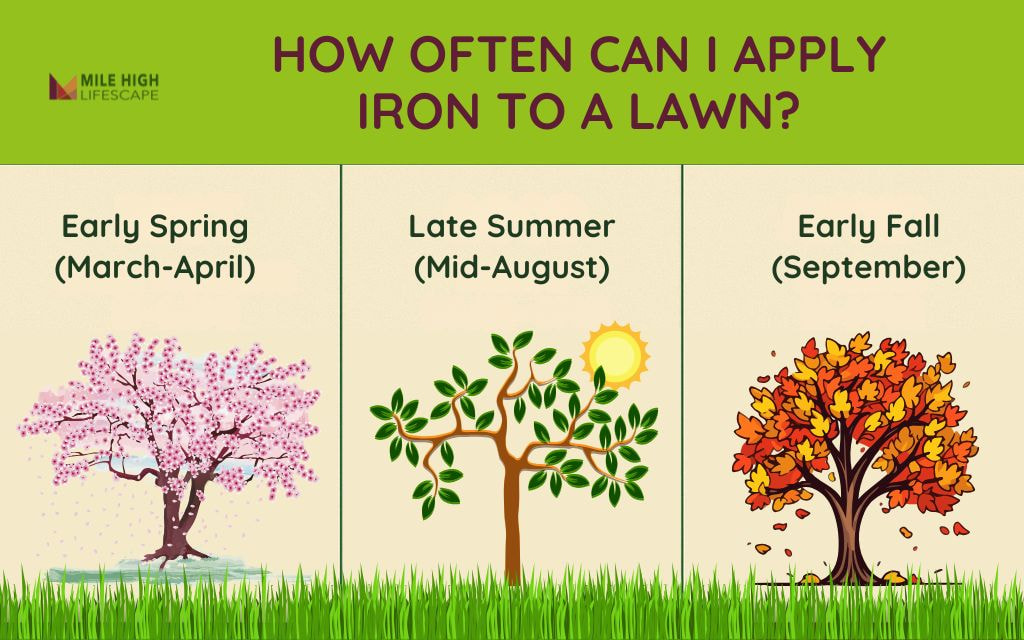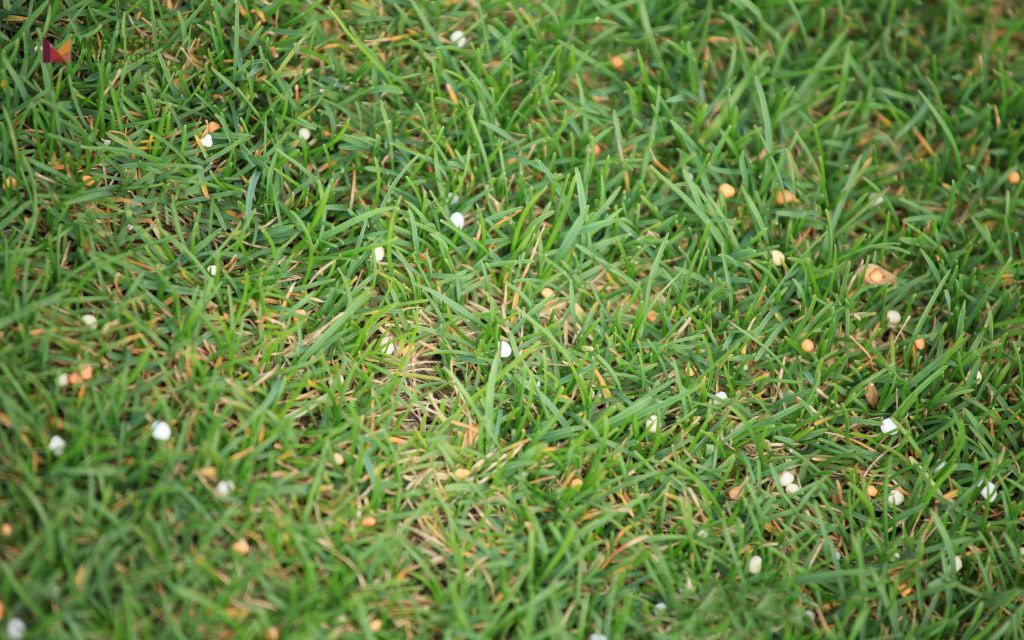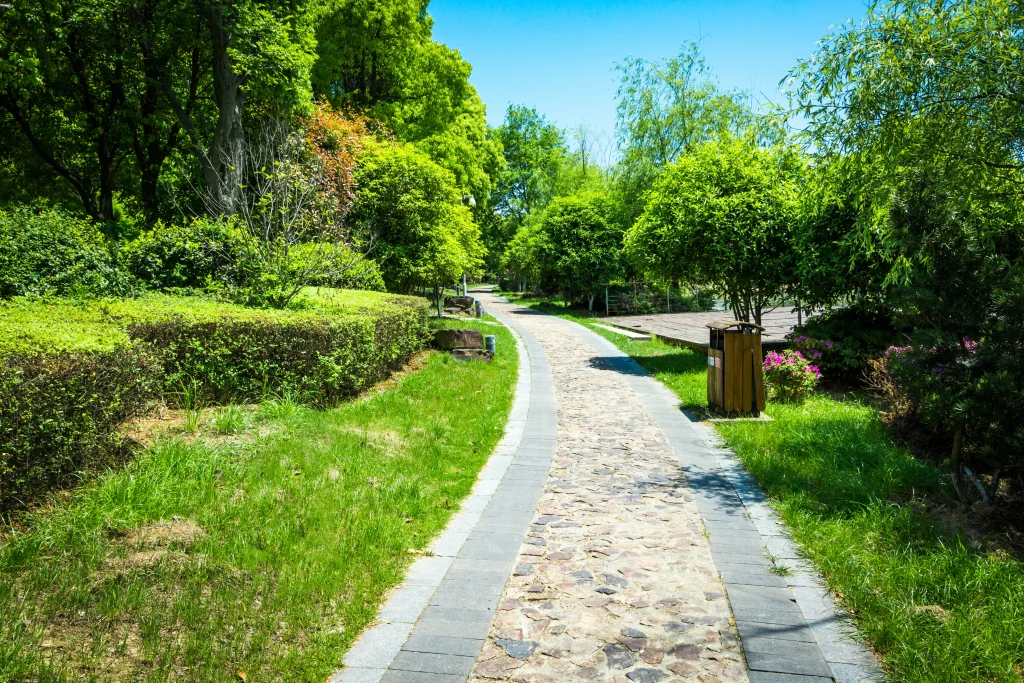How often can I apply iron to a lawn? Generally, you can apply iron to your lawn every 2 to 4 weeks, depending on the product and your lawn’s specific needs. However, most iron supplements should not exceed 4 applications per year to prevent toxicity and soil imbalance.
Iron plays a fundamental role in your lawn’s vitality and appearance. This essential micronutrient drives chlorophyll production, which gives grass its vibrant green color.
Without sufficient iron, your lawn may develop chlorosis – a condition where grass blades yellow despite adequate water and fertilizer. The alkaline soils and high altitude of Denver create unique challenges for lawn care, often limiting natural iron availability to grass roots.
This guide will help you understand when and how to apply iron correctly to avoid common pitfalls while maximizing the health benefits for your lawn.
Signs Your Lawn Needs Iron
Your lawn communicates its iron deficiency through several visible symptoms:
- Interveinal chlorosis: Yellowing between leaf veins while veins remain green, creating a distinctive striped appearance
- Stunted growth despite regular fertilization and proper watering schedule
- Patchy growth patterns, particularly in areas with highly alkaline soil
- Slow recovery after drought stress or heavy use
- Dull, pale appearance even with sufficient nitrogen fertilization
- Thinning grass in sections previously healthy and thick
- Poor response to standard fertilization programs
Denver’s high elevation, intense sunlight, and alkaline soils create perfect conditions for iron deficiency, making these symptoms more common than in many other regions.
How Often Can I Apply Iron to A Lawn in Denver?
The optimal frequency for iron application depends on several factors including soil conditions, grass type, and the specific iron product used.
For most lawns, apply iron 2-3 times per year, focusing on these key periods:
- Early Spring (March-April): Apply when grass begins active growth to promote strong early-season development and resilience against spring stresses.
- Late Summer (Mid-August): Consider a light supplemental application to support recovery from summer heat stress and prepare for fall growth.
- Early Fall (September): This represents the optimal time for a final application, supporting root development before winter dormancy.
The following schedule outlines the ideal timing based on the predominant grass types:
| Season | Best Time for Application | Grass Type Recommendation |
| Early Spring | March-April | Kentucky Bluegrass, Perennial Ryegrass |
| Late Summer | Mid-August | Tall Fescue, Fine Fescue |
| Early Fall | September | All cool-season grasses |
Denver’s unique climate with 300+ days of sunshine and fluctuating temperatures requires adjusting this schedule based on current conditions. During extended drought or unusually cool periods, postpone applications until conditions improve to maximize effectiveness.

Why Iron is Essential for Your Lawn’s Health
Iron functions as a catalyst for chlorophyll production – the compound responsible for capturing sunlight and converting it to energy through photosynthesis. Without sufficient iron, grass cannot produce adequate chlorophyll, leading to yellowing and weakened growth.
Why Denver cause iron issues:
- High soil pH (typically 7.5-8.0) locks up iron, making it unavailable to grass roots
- Intense UV radiation at higher elevations increases chlorophyll breakdown
- Rapid temperature fluctuations stress grass, increasing micronutrient demands
- Water restrictions limit the ability to flush alkaline salts from soil
Iron applications provide critical benefits:
- Enhances deep green coloration without excessive growth surges
- Improves photosynthetic efficiency and energy production
- Strengthens cell walls, improving resistance to foot traffic and disease
- Increases drought tolerance by promoting deeper root development
- Complements nitrogen fertilizers for balanced growth and color
4 Types of Iron Lawn Supplements
Selecting the right iron product significantly impacts effectiveness:
Iron Chelates (EDDHA, EDTA, DTPA)
- Most effective option for alkaline soils
- Remains available to plants despite high pH levels
- Provides rapid color response, typically within 2-3 days
- More expensive but requires fewer applications
- Ideal for severe iron deficiency correction
Iron Sulfate
- Traditional and economical option
- Works well when soil pH is below 7.0
- May stain concrete and other surfaces
- Less effective in Denver’s native alkaline soils
- Requires acidifying agents in most applications
Liquid Iron Supplements
- Fast-acting with visible results within days
- Provides both foliar and root uptake
- Easier to apply evenly across the lawn
- May require more frequent application (every 3-4 weeks)
- Excellent for quick correction of yellowing
Granular Iron Fertilizers
- Often combined with macronutrients (N-P-K)
- Provides slower, extended release
- Less likely to stain hardscapes when applied correctly
- Requires watering-in for activation
- Good for maintenance after correcting deficiencies
For Denver’s soil conditions, chelated iron products typically deliver superior results with fewer applications.

How to Apply Iron to A Lawn Correctly?
Follow these steps to maximize the effectiveness of iron applications on your lawn:
- Test Your Soil: Before applying iron, verify the need through a soil test. Denver soils typically have sufficient iron content but at unavailable pH levels (above 7.0). Testing confirms both iron levels and pH.
- Select the Appropriate Product: For Denver’s alkaline soils, choose iron chelates (particularly EDDHA formulations) for maximum availability. Liquid applications typically outperform granular products in high pH conditions.
- Prepare Your Lawn: Water thoroughly 24-48 hours before application to ensure active growth and maximum nutrient uptake. Never apply to drought-stressed turf.
- Apply During Optimal Conditions: Schedule applications for early morning or evening when temperatures remain below 85°F. Avoid application before rain or during wind to prevent runoff and uneven distribution.
- Use Proper Equipment: For liquid applications, use a pump sprayer with a fan tip nozzle for even coverage. For granular products, calibrate your spreader according to product specifications.
- Apply at Correct Rate: Follow product labels carefully – excess iron can damage grass and create long-term soil imbalances. Start with the lower recommended rate for first applications.
- Water Appropriately: Water lightly after granular applications to move product to soil level. For foliar sprays, allow 4-6 hours of dry time before irrigation for maximum leaf absorption.
- Document Your Applications: Keep records of products, rates, dates, and results to refine your approach over time.

Tips and Tricks for Iron Application
These professional insights will help you achieve maximum benefit from your iron applications:
- Start with reduced rates in new programs, especially with liquid iron. Denver’s high UV levels can increase the risk of foliar burn if application rates are too high.
- Combine iron with humic acid to improve uptake and extend color response, particularly effective in our mineral-heavy Colorado soils.
- Avoid mixing iron with phosphorus fertilizers, which can bind with iron and reduce availability.
- Test spray pattern on an inconspicuous area before full application to check for potential staining issues.
- Consider soil amendments like elemental sulfur or gypsum to gradually lower soil pH in severely alkaline areas.
- Apply iron separate from broadleaf herbicides to reduce the risk of turf injury, especially during summer heat.
- Monitor irrigation systems to prevent staining of structures and hardscapes from iron-rich water runoff.
- Supplement with manganese in comprehensive micronutrient programs, as manganese deficiency often accompanies iron deficiency.
Conclusion
Iron serves as a critical component for maintaining vibrant, healthy lawns in a challenging growing environment. By applying iron 2-3 times annually during key growth periods, you’ll develop deeper green color, improved stress tolerance, and overall turf vitality.
Remember that frequency matters – more applications doesn’t necessarily yield better results, and excessive iron can damage your lawn.
The key to success lies in proper timing, appropriate product selection, and consistent application techniques. By following the guidelines outlined above, you’ll establish a maintenance program promoting sustainable lawn health.
For personalized recommendations tailored to your specific lawn conditions, soil type, and grass varieties, contact Mile High Lifescape. Our lawn care specialists provide professional iron treatments and comprehensive lawn health programs designed specifically for Denver’s challenging climate.
Frequently Asked Questions (FAQs)
How often can I put iron on my lawn?
You can typically apply iron to your lawn every 2 to 4 weeks during the growing season if using liquid formulations. With granular products, limit applications to every 6-8 weeks. However, most lawns require only 2-3 applications per year when timed properly with seasonal growth cycles.
Can you put down too much iron on a lawn?
Yes, excess iron can damage your lawn by causing toxicity symptoms including blackening of grass blades, stunted growth, and root damage. Iron can also build up in soil over time, creating imbalances that affect other nutrient uptake. Always follow label rates and avoid the temptation to apply more frequently than recommended.
When not to apply iron to the lawn?
Avoid applying iron during dormant periods when grass isn’t actively growing, during extreme heat (above 85°F), before forecasted heavy rain, or when drought stress is evident. For Denver lawns, avoid applications during winter dormancy (November-February) and during mid-summer heat stress periods unless using very light rates.
How long does it take for iron to work on grass?
Liquid iron applications typically show visible greening within 1-3 days in Denver conditions. Granular formulations may take 5-7 days to show results, depending on irrigation practices. Chelated products generally work faster than non-chelated forms, particularly in our alkaline soils. Complete color development usually requires 7-10 days.
Does my lawn need lime or iron?
Lawns rarely need lime applications as our soils are naturally alkaline (high pH). In fact, lime would further raise soil pH, potentially worsening iron deficiency symptoms. Most yellowing lawns benefit from iron rather than lime. Only consider lime if a soil test specifically indicates acidic conditions below pH 6.0, which is uncommon in our region.
